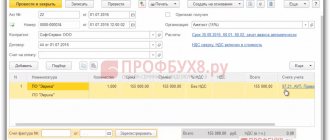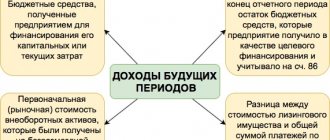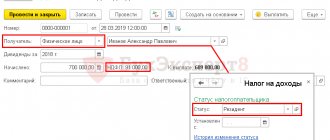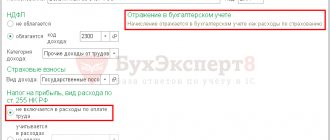Deferred expenses in 1C Accounting 8.3 mean those expenses that we incurred in the past or reporting periods, but they will be included in the cost of goods or services we produce in the future. Simply put, we bought it now, and we will have income in the future.
For example, we bought the 1C:ERP program. This program will allow us to reduce the labor costs of employees (dispatchers, technologists, storekeepers). Thus, we will not have to subsequently increase our staff. We will also be able to optimize production costs and workload of production workshops. The program will also allow us to make plans correctly, which will undoubtedly affect the company’s revenue in a positive direction.
Expenses for the purchase of software can be classified as deferred expenses in accordance with the second paragraph of paragraph 39 of PBU 14/2007.
Deferred expenses can be written off daily, monthly, lump sum and in any other way at your discretion.
The concept of future expenses and the nuances of their recognition and write-off
Future expenses or, as they are commonly called, deferred expenses (FPR) are expenses incurred by the company in past and (or) current periods and subject to write-off in subsequent time periods.
RBP are an object of accounting, although mention of such a term is rarely found in accounting and tax regulations. For example, it is absent in the Tax Code, IFRS, and Law No. 402-FZ dated December 6, 2011 on accounting.
Find out how to take into account future expenses in ConsultantPlus. If you do not have access to the K+ system, get a trial online access for free.
Based on the definition formulated by legislators in paragraph 65 of the regulations on accounting and reporting, approved by order of the Ministry of Finance of Russia dated July 29, 1998 No. 34, expenses incurred in the reporting period relating to subsequent reporting periods are written off according to the scheme established for writing off the value of the assets of this species, during the time period to which they belong.
Classification of RBP and determination of algorithms for their write-off is a procedure based on detailed knowledge of the legislation and practical experience of an accountant (financial specialist).
The absence in the legislation of a specific list of costs classified as RBP gives rise to various approaches by accountants of different companies to reflecting and writing off RBP in accounting and reporting.
Since the set of costs incurred by different companies depends on the specifics of the activities of a particular company, the nuances of recognizing BPR and the algorithm for accounting for them may differ. These features must be provided for by including in the accounting policy a separate section dedicated to this issue.
When starting the process of classifying RBP, you should be guided by the requirements of the following regulatory documents:
- accounting provisions containing a direct reference to the recognition of RBP (PBU 2/2008, 14/2007).
- PBU 10/99 “Expenses of an organization”, approved by order of the Ministry of Finance of Russia dated 05/06/1999 No. 33n (clause 19), establishing the use of an approach in accounting based on the uniform recognition of expenses.
The costs that fall into the category of RBP on the basis of these groups of regulatory documents will be discussed in more detail in the next section.
Inventory report 97 accounts in 1s 8 3
To do this, open the “Future Expenses” directory. It is located in the "Directories" section.
We will indicate “1C:ERP Program” as the name.
In the fields “Type for NU” and “Type of asset in the balance sheet” we will leave the default values. In the “Amount” field we indicate the cost of the program we purchased – 360,000 rubles.
We will process the purchase of the 1C:ERP program through the document “Receipt (invoice acts”). It is located in the "Purchases" menu. In the document list form that opens, click on the “Receipt” button and select the “Services (act)” item.
We will not describe in detail how to fill out the header of the document.
Where in the accounting program 8 2 is the inventory of deferred expenses located?
The write-off amount is calculated according to the algorithm indicated below and based on the remaining amount to be written off according to accounting data. We will indicate here the domain purchase amount – 2600 rubles.
in a year. In the write-off parameters, we will indicate the frequency. For example, “By month”. Let the cost account be 26.
Cost item – “Other expenses”. All that remains is to indicate the period for which the expenses should be completely written off.
Let's say we plan to launch and make our website popular in 4 months. The unwritten-off balance of costs at the time of inventory, determined by calculation.
14, 15 Inventory results - the amount of costs that need to be written off or restored according to the reconciliation data.
The columns are filled in if there are discrepancies in columns 9 and 13. Based on the results of the table, the results are summarized in the last line.
Attention The reflected results of the inventory of deferred expenses are certified by the signatures of the commission members.
cash inventory act in 1s 8 3
(Section Reports – Standard reports – Account turnover).1.
Select 51 invoices in the header.2. On the “Grouping” tab, indicate the frequency of generating the report – By day, grouping method – Bank accounts. Advertisement here 23. On the “Selection” tab, select the desired bank account.4.
On the “Indicators” tab we indicate the data to be displayed in the report. See attachment. Data displayed in the report in 1C 8.
3, allow you to check the balances and turnover of funds on the current account for each day of the selected period. Currently not implemented. We finalize this report or fill it out in Excel ourselves.
We issue INV-22 in the same way as for account 51. Address: 196084, Russia, St. Petersburg, st. Zastavskaya, 22, building 2, lit.
How to conduct an inventory in 1C 8.3 Accounting
Let’s fill in the header of the document with the details “Organization”, “Warehouse”: The next stage is filling in the accounting quantity of goods in the warehouse.
To do this, click above the tabular part “Fill” - “Fill according to warehouse balances”: Please note: The accounting quantity is filled in as of the document date, and not at the current moment! A list of all available goods will appear in the table (according to accounting data in the 1C program): We see two columns:
- Quantity fact - this data must be filled in based on the actual balances in the warehouse. By default, 1C fills in these quantities from the credentials.
- Quantity accounting - how much product is in stock according to the program data.
Now the most interesting thing is that we count how many goods are actually in stock and enter them in the “Actual Quantity” column: Once all the data is entered, write down the document.
Now you can print the necessary primary documentation by clicking on the “Print” button:
Deferred expenses in 1C 8.3, inventory, write-off, accounting
The accounting chart of accounts is available from the “Main” section of the main interface of the system: Active account 97 reflects information about expenses that occurred in a given reporting period, but relate to future reporting periods.
Each type of expense can be separated into a group of elements of the “RBP” directory, and each expense is its final element.
The RBP element card in 1C Accounting 8.3 contains the necessary details that allow you to display assets in the balance sheet and write them off as expenses for the current period.
advokatymurmanska.ru
Among the members of the commission there are usually employees of accounting, economic or technical departments, and a representative of the management team of the enterprise.
It is not allowed to include in the commission financially responsible persons who are in charge of the assets being inspected.
Important The organization has the right not to use a unified form, but to prepare its own act form, which will reflect information about expenses for future periods.
You can also take the existing INV-11 form as a basis and adjust it to suit your needs.
In this case, the accounting policy must indicate which forms the organization will use to conduct inventory. We will indicate the start date of write-off and the end date accordingly. Get 267 video lessons on 1C for free: Free video tutorial on 1C Accounting 8.3 and 8.2; Tutorial on the new version of 1C ZUP 3.0; Good course on 1C Trade Management 11.
Inventory of rbp in 1s 8 3
After correcting errors in accounting, you must once again close the month in 1C 8.3.
Login / Registration Evgeny Belozerskikh Qualification: Programmer-Consultant Author of the development Evgeny Belozerskikh
- Age: 32 years
- 1C experience: 8 years
Contacts Show Configuration: Enterprise Accounting 3.0 Platform version: 8.3 Cost, rub: Free Processing file: Download Report “Unified Form INV-11 for inventory of deferred expenses”, configuration “Enterprise Accounting ed. It is more convenient to make it short and informative, so that it is easier to use the quick search in the program.
And the full name is the name of the item from the receipt document.
Both of these names may coincide (then select the name from the receipt document): It is very important for the integrity of accounting in 1C 8.3 Accounting 3.0 to create one card for one type of item.
Unified form No. INV-11 - form and sample
Fill it out in 2 copies.
The first is sent to the accounting department, and the second remains at the disposal of the commission, which conducts the inventory.
Representatives of the relevant commission, as well as the financially responsible person, sign both copies.
To fill out the INV-11 form, accounting records for account 97 and information obtained when checking this data during the inventory are used.
For information on the document establishing the subject, time frame for conducting the inventory and the composition of the commission carrying it out, read the article.
The act, which is drawn up in the INV-11 form, records:
- amounts to be written off as the cost of goods (per month or from the beginning of the year);
- name of expenses of the future period;
- the amount of the estimated amount to be written off for each expense;
- amounts to be added or restored based on inventory results.
- the volume of write-offs already made and the balances of unwritten-off expenses as of the beginning of the inventory;
- the date of occurrence of the relevant expenses and the period for their repayment;
- the amount of the estimated balance of the relevant expenses, which is subject to repayment within the framework of a future period;
- the duration of the period between the inventory date and the moment expenses are incurred (in months);
- the total amount of relevant expenses;
For information on the form used to reflect data on verification of settlements with counterparties, read the material.
Difficulties in recognizing costs and the algorithm for writing them off
The following expenses can be safely recognized as future expenses (since this is directly stated in the legislation):
- For preparatory work - carried out in connection with upcoming projects. They are written off as revenue under the contract is recognized (clause 16 of PBU 2/2008 “Accounting for construction contracts”, approved by order of the Ministry of Finance of Russia dated October 24, 2008 No. 116n).
- In the form of a one-time (fixed) payment - for the right obtained by the company to use the results of intellectual activity (or means of individualization). It is recognized as expenses during the period of validity of the agreement (clause 39 of PBU 14/2007 “Accounting for intangible assets”, approved by order of the Ministry of Finance of Russia dated December 27, 2007 No. 153n).
In relation to other costs, which are written off evenly, their classification as part of the BPR requires a serious analytical approach from the accountant.
The main difficulty with this classification is whether to consider incurred costs as an asset or to recognize an expense? The following algorithm can help you figure this out, helping to classify costs as an asset:
- find out whether this asset will bring economic benefits to the company in the future;
- determine the degree of its control (whether the company has the right to receive cash inflows from its use in the future, as well as limiting access to such benefits for other persons).
At the same time, the company is likely to have future economic benefits if it has the opportunity to:
- use the asset in the activities of the company;
- repay their obligation or exchange;
- distribute the asset among the owners of the company.
If costs do not meet the criteria of an asset, they are recognized as expenses.
Correct classification will help to avoid errors in the reflection of RBP in financial statements, as well as to apply the necessary method for their write-off.
To clarify this difficult task, officials of the Russian Ministry of Finance gave the following explanations (letter dated January 12, 2012 No. 07-02-06/5):
- if the costs incurred by the company comply with the conditions for recognizing a certain asset established by accounting standards, these costs are reflected in the balance sheet as part of this asset (fixed assets, intangible assets, inventories) and are written off in the manner established for writing off the value of this asset;
- in other cases, costs are reflected in the balance sheet as BPR and written off by their reasonable distribution between reporting periods in accordance with the algorithm established in the accounting policy.
Get acquainted with international approaches to asset valuation using the materials on our website:
- “IFRS No. 38 Intangible assets - application features”;
- “IFRS No. 16 Fixed assets - application features”.
Deferred expenses: what has changed and how to reflect it in “1s:accounting 8”
STEP 6 Issuing an invoice for services In our example, the right to use the Program “1C: Accounting 8.2 rev. 2” is transferred on the basis of a license agreement, which, in accordance with clause 26 of Article 149 of the Tax Code of the Russian Federation, is not subject to VAT. In addition, Business Guide LLC uses the simplified tax system, so it does not issue an invoice.
Important
For these reasons, in our example we do not register an invoice. STEP 7 Checking the RBP in the program Checking the loss accounting account for the RBP (Fig.
326) To do this, it is necessary to create a balance sheet for account 97.21 “Other deferred expenses”:
- Menu Reports – Account balance sheet;
- Specify the period, select Account (in the example –97.21);
- Click the "Generate report" button.
Rice. 326 As can be seen from the balance sheet for account 97.21 “Other deferred expenses,” the correct amount of deferred expenses is taken into account.
Postings for writing off deferred expenses
After the procedure for classifying RBP, their value is reflected in accounting and is gradually written off using the following correspondence of accounts:
- Dt 97 Kt 60 (76) - costs are taken into account as part of the RBP;
- Dt 20 (25, 26, 44) Kt 97 - partial write-off of RBP.
An important nuance in this regard is the period for writing off the RBP. If it is not specified in the contract, it is determined independently, taking into account the method of writing off the RBP fixed by the accounting policy. This method can be used:
- algorithm for uniform write-off of RBP over the time established by order of the head of the company;
- the method of writing off RBP in proportion to sales income;
- other ways to write off RBP.
Filling out the INV-11 table
| Column number | Information to be filled in |
| 1 | The sequence number of the table row. |
| 2 | Type of expenses related to future periods (this can include not only the costs of licensed software and construction, but also other expenses for which clear write-off rules are not established, and therefore, in the accountant’s opinion, they can be classified as expenses of future periods) . Typically, if expenses in tax accounting are written off gradually, then in accounting they are also included as expenses over a long period. |
| 3 | Expense type code, filled in if appropriate coding is available. |
| 4 | The amount of costs incurred in the current period and related to future periods, or costs incurred in previous periods and not completely written off in the current period. The column is filled in based on the account balance 97. |
| 5 | Cost incurrence date:
|
| 6 | The period over which costs must be written off as expenses, expressed in months. |
| 7 | The amount of costs that should be written off on the date of the inventory is filled in based on the calculations made. |
| 8 | The actual amount of written-off costs on the day of reconciliation according to accounting data. |
| 9 | The unwritten off balance as of the day of the inventory according to accounting data. |
| 10 | The number of months that have passed since costs were recorded as deferred expenses. |
| 11, 12 | The amount of costs to be attributed to the cost of production, according to primary documents. |
| 13 | The unwritten-off balance of costs at the time of inventory, determined by calculation. |
| 14, 15 | Inventory results are the amount of costs that need to be written off or restored based on the reconciliation data. Columns are filled in if there are discrepancies in columns 9 and 13. |
We invite you to read: The car dealership returned the faulty car, saying that there were no problems found with the car.
The results of the table are summarized in the last row.
The reflected results of the inventory of future expenses are certified by the signatures of the commission members. The signatures of financially responsible persons are also affixed, who, by signing the act, confirm that the information contained in it corresponds to reality, these persons have no complaints or claims to the information presented.
After completing all the necessary manipulations with the inventory report INV-11, it is transferred to the accounting department for verification. It is not necessary to draw up an additional comparison statement if discrepancies are identified in the act, since it includes the functions of such a statement.
The employee, who has checked the data given in the inventory act, indicates his position, writes his last name, and signs. Such acts must be kept for at least 10 years.








